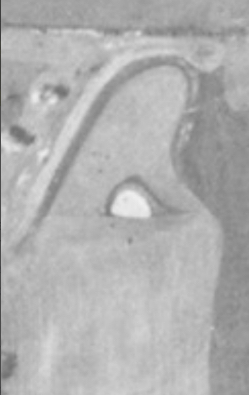Here’s a book concept for any number of the golf historians / architecture aficionados I follow on Twitter: The Redans of Raynor. A chapter dedicated to every Redan that Seth laid out. It could be a fine book, and Redans are a fine concept, but there is a point where the tried and true needs a rest. You and the missus need something slightly more exotic from the Raynor repertoire.
Here lies the Lion’s Mouth, a template (in some circles) that Raynor didn’t attempt to place at every routing. You’re probably familiar with the concept already; a large bunker cutting into the front of the green, both discouraging the ground game (a generalization) and muddling the distance to the flag. As opposed to the Redan—which is always en vogue—the Lion’s Mouth has had a few flash-in-the-pan moments over the past few years that have driven newfound interest to this relative rarity. For one, Keith Rhett and Riley Johns incorporated the concept during the drivable No. 6 at the hip Winter Park nine north of Orlando. More so, the U.S. Women’s Open at the Country Club of Charleston brought wide eyes to the intimidating bunker laying at the feet of No. 16’s green.
So let’s keep that momentum moving into 2020. More accurately, Fox Chapel Golf Club will keep that momentum rolling.
Fox Chapel, like many of Raynor’s most esteemed tracks—Fishers Island, Camargo, Yeamans Hall—is essentially a collection of templates spun to the local land. Unlike all those aforementioned classics, Fox Chapel features a Lion’s Mouth.

That’s a fact as of the 2020 playing season. It has not been a fact for nearly 90 years previously, based on the estimates of Spencer Hennen, assistant superintendent. He says the actual date remains unknown, but it’s widely believed that A.W. Tillinghast advised the hazard be removed from No. 9 to trim fat during the Depression, while consulting for various Pittsburgh clubs (a letter regarding his work, although leaving the Lion’s Mouth unmentioned by name, is featured at the bottom of this post). “He came in and essentially he removed a lot of bunkers, changed the course to make it more financially sustainable,” Hennen says of Tillinghast’s work. “So we’re thinking that’s around the time it was taken out. Because a bunker in the middle of the green, especially back then, wasn’t very sustainable.”
Those changes, and other rounds of edits, sat for nearly half a century. A major turning point was the 1985 U.S. Women’s Amateur Championship, when the shift away from Raynorian principles became painfully obvious (i.e. the front portion and canyon in the Biarritz were maintained at fairway length). The fuse was lit. Brian Silva began a long relationship with the club, restoring green dimensions and bunker styles, and eventually the club established a relationship with Fazio Design during 2014 (Tom Marzolf has been handling the design work).

There’s a misconception floating in some internet crannies that a master plan for a full renovation is in play (this is not the case, due to budget constraints). It was important to Hennen and the greens committee, however, to return bold, Raynorian elements. It’s tough to craft a bolder comeback than the Lion’s Mouth at “Dustpan,” No. 9 at Fox Chapel.
First, consider the hole at this point during 2019. A 450-yard Par 4, straightaway, with a green angled from front-left to back-right. Two fairway bunkers covered the right side from about 200 to 260 yards out from the tee, with two more bunkers pinching the left and right run-up to the green. The green is not without distinction,, however, even sans Lion’s Mouth: A spine runs front-right toward back-left, separating maybe the front 75 percent of the green from the remaining back right.
Fast-forward a year. The two greenside bunkers are gone, replaced by a central Lion’s Mouth hazard. The bunker was recreated using the original aerials, laid over modern drone footage. The result is the new, triangular centerpiece.



This rendition of the Lion’s Mouth green separates itself from Charleston’s in numerous ways. For one, although both feature some degree of false front, Fox Chapel’s will allow some run-up (more on that in a minute), while Charleston’s monstrosity makes such an idea absurd. Both make playing to the center of the green the ideal option, but the Charleston version is head-on for the approach. The angling of the Fox Chapel green, as well as its spine, add a new dimension to play, depending on flag position. For one, Hennen cites the spine as a great “backboard” for those playing to frontward pins. On the other side of the coin/spine, getting over that spine to reach back pins will be a thrilling prospect (Hennen notes that the renovation has opened up more pinnable locations).
Also notable is the shape of the green. Charleston’s features “jowls” at the front, but otherwise takes a more cubist shape, in true Raynor fashion. Fox Chapel’s has the angle, of course, but it’s worth noting the green extends a tongue to the left side of the Lion’s Mouth, while the right side remains tucked behind. This is a tribute to Hole O’Cross, No. 13 at St. Andrews, which is the spiritual ancestor for the “Lion’s Mouth” concept.
It’s a wonderful green. But let’s be honest: It’s not so tough to beat the bunker. Hennen notes that once you cross that rubicon, winning this green isn’t all that challenging. Which is why the bunker restoration on the cross bunkers at No. 9 may be even more valuable to the “Lion’s Mouth” template than the Lion’s Mouth itself.

These are similar to the first set of fairway bunkers present at Charleston. The left of the two is a bit closer to the tee, and therefore a tad easier to carry. Carrying the right leaves a short iron to the green. The placement of these bunkers (as well as the flaring of the fairway to encourage a carry) shifts the player’s thinking entirely whilst on the tee; in the past, it’s tough for my Calvin Peete to imagine putting the driver away while playing No. 9. Now, anything from driver down to long iron is a possibility.
So how do members feel about the newly challenging No. 9? Certainly good enough to move the project forward.
“Our membership’s very passionate about their golf course. Very passionate about golf course architecture,” Hennen says. “We didn’t really get any pushback at all on the Lion’s Mouth. I think everyone was excited. It’s a spectacular green to look at.”
Charleston’s Lion’s Mouth features high sides to create some punchbowl generosity. Did Fox Chapel’s pack such a feature? Photos from the ‘30s indicate that a horseshoe-like slope circled the green, although the role/roll of the feature during Raynor’s time is unclear. Hennen and Co. chose to walk the fine line between idealism and realism, bringing bentgrass up the slope, in effect creating a punchbowl. This, and the wide pathway to the left of the Lion’s Mouth, offers more options for weaker hitters. It’s a reasonable adaptation for a membership that is, no offense, older than your correspondent.

The Lion’s Mouth will open for member play this Spring, but aesthetic reception has been enthusiastic thus far. The club is already moving forward with restoring some of Raynor’s other headline-worthy features, including the original reverse-Road Hole green at No. 4, and shaping No. 5’s green to better resemble Seth’s original “clover” appearance.
So where will the next big Lion’s Mouth news piece come from? BPBM has a suggestion, and it’s another No. 9…located outside of Augusta, Georgia.